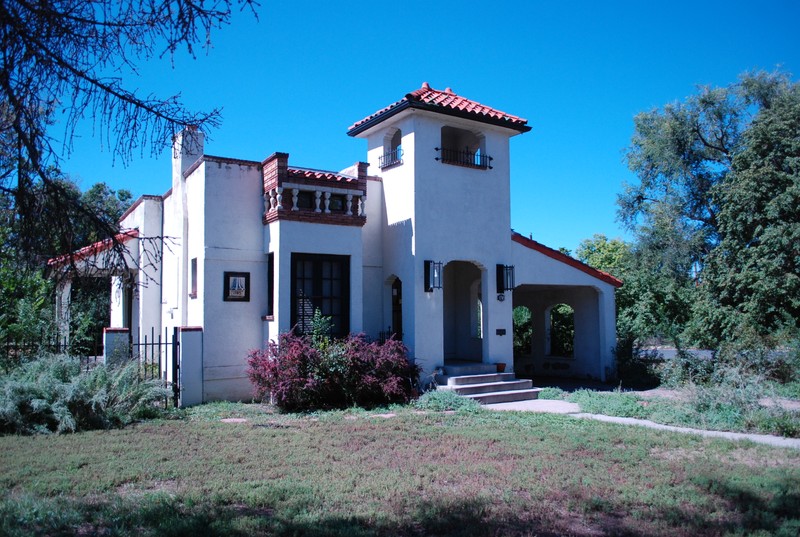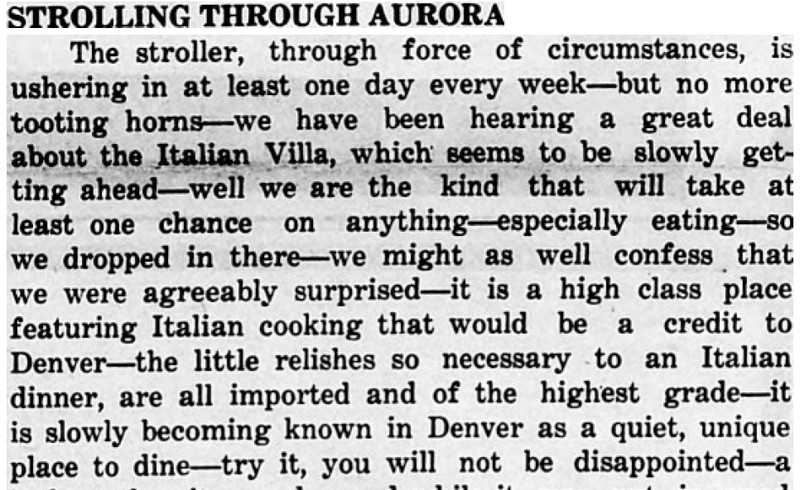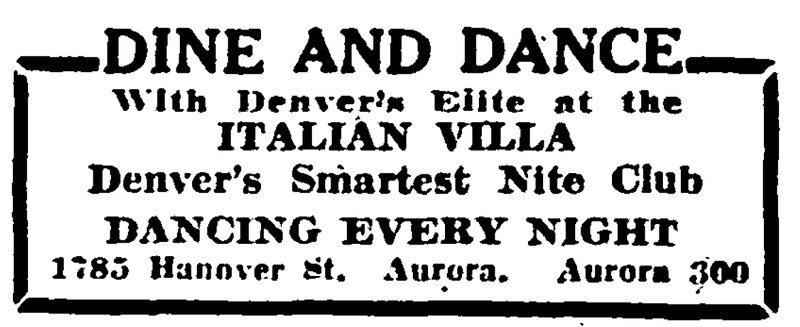Italian Villa
Introduction
Text-to-speech Audio
Images
Italian Villa

"Strolling Through Aurora"

Italian Villa Advertisement

Backstory and Context
Text-to-speech Audio
Spanish Colonial Revival:
Prior to the Panama-California Exposition of 1915, no prominent architectural style was influenced by Spanish Colonialism. The exposition, held in San Diego, California, displayed Spanish influence around the world and was well received by both the public and architects. The style found prominence in states with pre-existing Spanish influence, mainly California, Arizona, New Mexico, and Florida, but dropped off heavily following 1940. Distinguishing architectural features include: a low-pitched tile roof with no eave overhang, stucco exterior, prominent arches, and an asymmetrical façade.
Prohibition in Colorado
Alcohol Prohibition in Colorado passed in November of 1914 and took effect in January 1916, four years before the passage of the 18th Amendment, which implemented National Prohibition. The prohibition movement, active since the mid-19th century and blustered by organizations like the Anti-Saloon League, found common ground with the Progressive movement, which sought to improve society through government interaction. These forces intersected a wave of xenophobia and religious fever that culminated in the passage of the state dry law. Attempting to halt crime, vice, and drunkenness, the ban on the transportation and sale of alcohol created an atmosphere of organized crime and corruption. Ultimately, National Prohibition came to an end in 1933 with the passage of the 21st Amendment.
The Italian Villa Restaurant/Night Club:
The Italian Villa Restaurant opened in 1925, nine years into Colorado prohibition. The restaurant found acclaim when Alex Maranzino took over in 1929, establishing the Villa as a quiet getaway for Denverites, offering quality food, live music, and an extensive garden patio. Known as the "summer garden," the outdoor space sat 150 patrons and featured a trout pond, dance floor, and a decretive awning that covered the entire patio. Rumored to have been a speakeasy and gambling club during Prohibition, the only written account of the restaurant violating the Volstead Act came in early 1933, after the administration of Franklin D. Roosevelt amended the Volstead Act to make 3.2% beer legal. Following local ordinance, Maranzino applied and paid for a license to sell the now legal beer.
Despite his compliance with local ordinance, Maranzino was arrested in August for breaking the 3.2% beer law. A crowd of Auroran's filled the courtroom in Brighton to hear the injunction brought on by Harry Behm, District Attorney. Behm immediately dropped the charge that Maranzino violated the 3.2% beer law and asked the court to close the Villa because it was a public nuisance. Several Auroran's testified to the character of Maranzino and the Villa, and by the days end the court dismissed the suit, stating:
"The overwhelming predominance of evidence is in favor of the defendant; it is plainly apparent that the people and officials of Aurora are in favor of the establishment and that Aurora has enough law to take care of any such place." (1)
Albeit Maranzio's victory, the cost of the court proceedings, coupled with the Great Depression's financial devastation, might have proven too much. In January of 1934, Maranzino and his family closed the restaurant and moved to nearby Denver for unknown reasons.
The Blanks:
Henry Blank was born on July 4, 1883 in Philadelphia, Pennsylvania to a Russian immigrants. At the age of fifteen, Henry enlisted with the New Jersey National Guard Volunteer Infantry following the start of the Spanish-American War in April of 1898. Enlisted as a Private in Company K of the 4th Regiment, he served at Camp Meade, Pennsylvania and Camp Wetherill, South Carolina until being mustered out on April 6, 1899.
Following his time in the New Jersey National Guard, Henry attended the University of Maryland, graduating in 1906 with a Doctors Degree. He moved to Denver seven years later, where he practiced medicine for the next twenty-two years, retiring in 1936. He married Lena La Bruzza in 1934 and moved into 1785 N. Hanover St. Henry passed away at the age of 70 in 1954. Lena continued to reside in the home until 1982.
Cite This Entry
Jacob Giretti McDonald on behalf of Aurora History Museum & Historic Sites. "Italian Villa." Clio: Your Guide to History. June 23, 2020. Accessed March 31, 2025. https://theclio.com/tour/1412/2
Sources
"Abatement Sought Against Night Club." The Denver Post (Denver ) August 21st 1933.
Abbott, Carl, Stephen J. Leonard, and Thomas J. Noel. Colorado: A History of the Centennial State. Edition 5th . Boulder , Colorado. University Press of Colorado, 2013.
Application for Headstone or Marker, Henry Blank, Company K, 4th Regiment, New Jersey Infantry, June 22, 1954, www.ancestry.com.
(1) “Case Dismissed: Jude Johnson Re-Fuses to Issue Injection,” Aurora Democrat, September 1, 1933.
Kyvig, David E.. Repealing National Prohibition. Edition 2nd. London. The Kent State University Press, 2000.
Division of Vital Statistics, State of Colorado, Marriage Record Report, Henry Blank and Lena La Buzza, July 21, 1934.
“Dr. Henry Blank,” The Denver Post, April 1, 1954.
Gerardin, Benjamin M.. Record of the Fourth New Jersey National Guard, Volunteer Infantry, Spanish-American War, 1898-1899. Jersey City, New Jersey. William Roeher.
“Grand Opening,” Aurora Democrat, June 23, 1933.
Leonard, Stephen J. Noel, Thomas J. A Short History of Denver. Las Vegas, Nevada. University of Nevada Press, 2016.
“Local News,” Aurora Democrat, January 5, 1934.
McAlester, Virginia Savage. A Field Guide to American Houses: The Definitive Guide to Identifying and Understanding America's Domestic Architecture. Edition 2nd. New York. Alfred A. Knopf, 2013.
“New Council Takes Office,” Aurora Democrat, April 14, 1933.
“New Music at the Villa,” Aurora Democrat, July 7, 1933.
Noel, Thomas J. The City and the Saloon: Denver, 1858--1916. Boulder , Colorado. University Press of Colorado, 1996.
Richthofen, Ted. Prohibition, Colorado Encyclopedia . Accessed June 11th 2020. https://coloradoencyclopedia.org/article/prohibition.
“Strolling Through Aurora,” Aurora Democrat, June 16, 1933.
United States Census Bureau. The Census of the United States, 1920 - 1930. Washington: Government Printing Office, 1920, 1930.
Aurora History Museums & Historic Sites
Aurora Democrat, June 16, 1933
The Denver Post, August 30, 1933

